I took what I consider to be a very brief break with the blogosphere and Mopar’s blind sample-othon because I was beginning to experience a bit of burnout. I may have mentioned in my first post/intro that I used to be a bass fishing nut that also happened to write for fishing magazines and websites. I even got paid to do it. It was amazing, until it wasn’t. I eventually began to experience burnout to the point where I stopped writing and fishing altogether. God forbid that that happens again. Oh, and do not be alarmed reader. You are always free to come to the table, and that means it is always free for you to join. I get nothing but enjoyment from this exchange and I intend to keep it that way.
That brings us to sample B.
I can’t recall when I even had it, but with burnout creeping in, I decided I would drink this one without taking notes and worrying too much about what it was. Sometimes you just need to be in the moment, and I’m happy that is what happened with this tea. It, as of now remains my favorite sample of the lot so far. The only note I shared with mopar was that I liked it a lot, and that it must be, B for Bulang. How fitting? There was part of me though that thought it might be mengsong. Regardless, it was bulang. A Cheng Shen Hao Big leaf cake from 2008. I certainly drank to my preferences. Properly transformed tea, with no storage notes. Big in body, but not overbearing. Very Fragrant, with a bit of a floral element in the huigan that reminded me a bit of Naka, hence the confusion. I would buy a cake of this (and plan to do just that).
Following B, I drank H. Here is my take on it.
There’s a little bit of storage aroma on the leaf, but nothing heavy. This is very tightly compressed but is not an iron cake from what I can tell. The rinse did not open things up at all so I had to break my sample apart afterwards. Mind you, mopars sample was very generous and I only had half of it. More to come on that later.
1st, 10s.
There are oils visible on top of the broth. The tea already has camphor. I taste a little humidity but nothing heavy. The huigan is light and almost floral in nature.
2nd, 10s.
There are still oils on the broth, and now it’s quite a bit darker. The color and compression indicate this has been aged for a while, and it is well aged. This has to be older than 2007 I think, but how much more I cannot tell. Every sip I’m immediately greeted with camphor. The huigan is strong. There is body to this tea, but it is subdued. The aging has been doing its thing. I definitely think the material was stout and the processing more traditional with this tea.
3rd, 15s.
It’s still very oily on top which comes across in the mouthfeel. Yes, this quite oily. There is that old book feel with some tobacco in the body of the tea. There is lots of camphor and lots of huigan that comes across as slightly floral. The sweetness is rock sugar.
4th, 25s
This infusion is presenting itself much the same as the others. I don’t see this changing in character. I’ll press this tea to test its longevity and I’ll note any changes. Speaking of changes, as I write there is a bit of vanilla creeping in which is new.
After this I stopped taking notes. The longevity was good, and the tea remained the same in its nature as it bottomed out. I think I recall noticing vanilla in the future infusions which is notable. I guessed that this was a dayi, older than 07, that likely had bulang in it but was probably a blend of material. I found out it was a Xiaguan. A 2011 Jin Se Chuan Qi. The maocha was aged for 7 years prior to pressing, which makes this older than 07. The storage was hk for three years, and then shanghai for the rest of its life before reaching mopar. That certainly aligns with my tasting.
Now, I enjoyed this tea immensely and the storage was huge. I say that, because I happen to own this cake. The only info I have on its storage, is that it was hk natural. I much preferred mopars sample and it never crossed my mind once that I might own this tea. Thankfully, I have another sessions worth of mopars and will do a side by side in the future that will be featured here.
Finally, LFPT. Or to you newcomers, 2013 Xiaguan Love Forever Paper Tong
If you’ve spent any amount of time online or in person with other puerh tea drinkers in the west, you’ve heard about this one. If you haven’t, you’ll hear about it soon: like right now. This is one of those hype train teas. I’ve never had it before now to be honest, and part of that is because I can’t afford it. I don’t buy samples, so the only way to try this one would be to have a sample gifted to me. Thank you mopar.
In another life, I was a serious bourbon collector/drinker. I don’t drink anymore but I certainly know enough about the hobby and where it stands even today. When I first got started, the bourbon boom was just taking off. It was hard to find certain products but not impossible. We’ll take the brand buffalo trace as an example. They had their holy grail product - the pappy line, which was always hard to find from my understanding. Then they had things like blantons and elmer t lee. I’d find those on the shelves but not often. Everything else they made, was usually readily available. Slowly, things like the elmer t lees and blantons could only be purchased via raffle or at a super inflated price. And now from my understanding, all of the buffalo trace line is like that - even their base product.
LFPT is the same in these regards. It is harder to find, and if you can find it, it is expensive. It wasn’t always this way of course. The hype caused it. Is the hype well-founded? I know for a fact, the standard buffalo trace line should not be scarce because it’s just average stuff. Thankfully, LFPT is not the same.
It is very good tea. I was greeted with flavors in sheng that I often do not get - Loads of fruit, strikingly so. Cherry Cola, with plums/prunes. Those notes carry out throughout the teas entirety. On top of that, Lots of camphor. There is noticeable QI, and if you’ve noticed here, I don’t mention that often. That is because I often don’t notice QI. Not so here. This tea is strong. Mopar said flash steeps, and I’m glad he did. That didn’t hamper the tea from being huge in flavor. The longevity was great too. The hype is well founded. If I were to ever find a cake in my price range, I would buy one. Of course, that time has passed. I’m grateful I got to try it regardless.

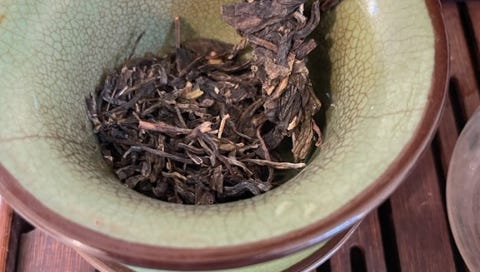



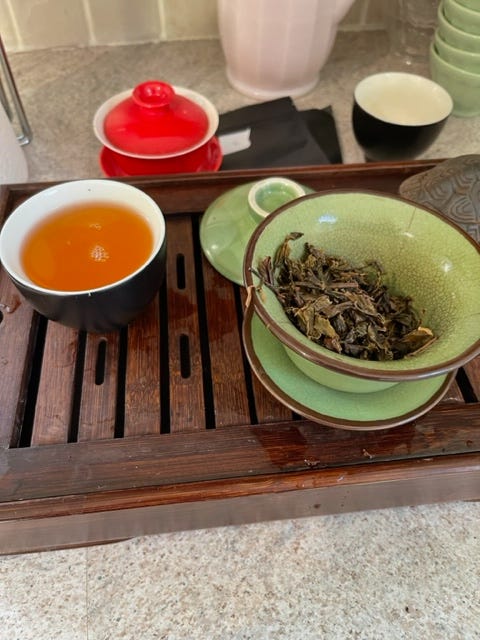
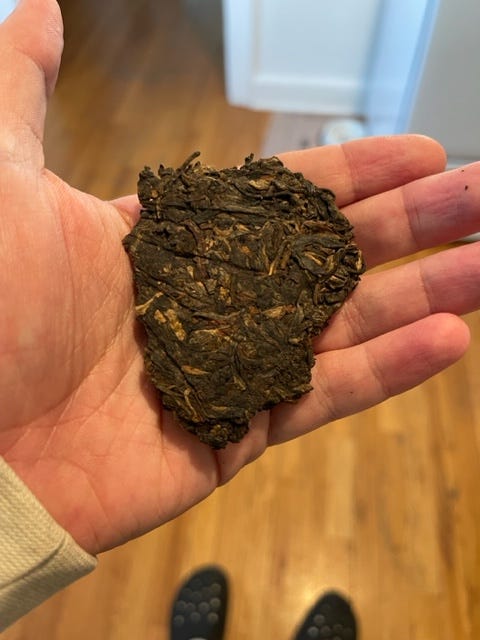
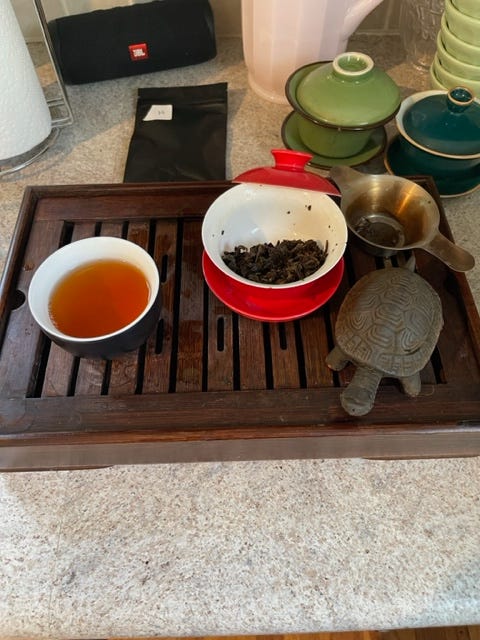
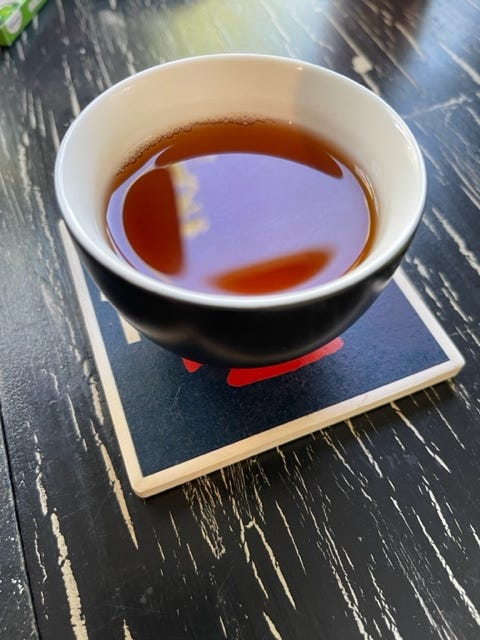
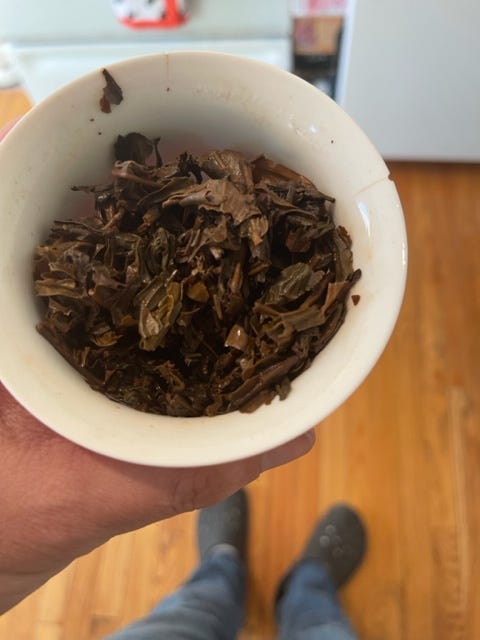
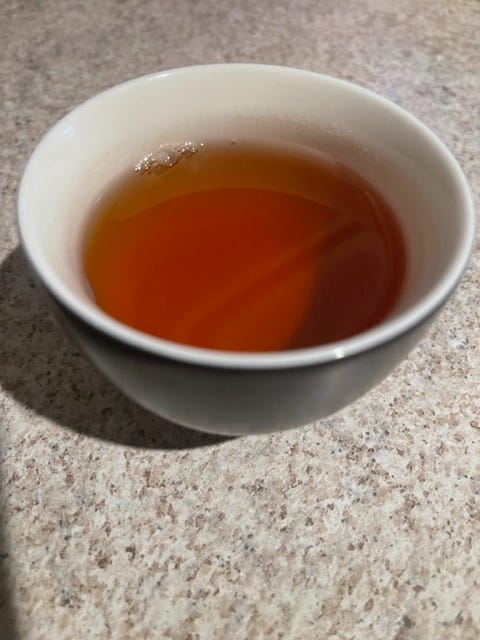
This cake is $150 - 200.
Is that expensive?
The green gaiwan is nice.